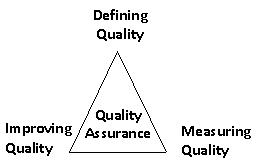
- First of all, we need to understand what family planning is
- Family planning (FP) can be defined as the voluntary decision made by the responsible individuals and couples in order to determine the desired family size and timing/spacing of births
- FP is mainly about planning a family through determining the total number of desired family members and timing and spacing of the child’s
- Now, when we look at quality assurance in family planning, since FP is an important component of Reproductive Health (RH) of an individual/couples, good quality of family planning services is of high importance
- Maintaining standard quality checks and specific quality assurance methods are also equally needed
- Maintaining quality in FP services actually means ‘meeting with the need of the clients/couples’
- Once the quality of service is maintained it is also the doorway to sustainable service
- Thus, providing quality service can be achieved through regular problem solving and quality improvement in the service delivery of chain FP
- This concept of quality assurance in FP has a long history, as International Conference on Population and Development (ICPD) in 1994 set broad agendas for including elements of quality in FP services
- Also it is necessary to know that Quality Assurance has three major functions: defining quality, measuring quality and improving quality.
 For quality assurance to be effective all these functions need to be undertaken in a balanced and steady way
For quality assurance to be effective all these functions need to be undertaken in a balanced and steady way - Quality Assurance Project (QAP) in 1992 was also a flagship program of USAID which defined quality assurance in health care into eight broad dimensions of:
- Technical competence
- Access to services
- Effectiveness
- Interpersonal relations
- Efficiency
- Continuity of services
- Safety
- Amenities
- As already mentioned, client satisfaction is at the heart of quality of care in FP services
- Moreover, good quality of care leads to client satisfaction, increase in knowledge about FP services among the client and effective, long and regular use of family planning devices. Also, it ensures safety, decrease in morbidity and mortality and increase in service coverage as well
- Quality of care in FP is well explained by the standard Bruce-Jain framework which is widely used in most of the FP programs. According to Bruce-Jain framework (1990), there are six elements of quality of care in FP services, which are:
- Choice of method
- Interpersonal communication (verbal & non-verbal)
- Technical Competence
- Information
- Follow-up
- Appropriate constellation of services
- Since 2000, the same Bruce-Jain framework has guided quality improvement approach in family planning
- There is also a specific set of quality assurance protocol developed by Population Service International (PSI) for improving quality of FP services. This quality assurance protocol has been widely used in Uganda and other African nations as well and has shown significant increase in access to high quality FP services. The quality assurance protocol includes:
- Need for continuous training of providers
- Supportive supervision
- Client exit interviews
- Annual internal and bi-annual external audit of FP services
- These protocols were based on global standards of PSI, which are technical competence, client safety, informed choice, privacy and confidentiality, and continuity of care.
- Some major advantages of quality assurance in FP services are:
- Increases client satisfaction
- Increase in service coverage
- Longer use of FP devices and rise in Contraceptive Prevalence Rate (CPR)
- Decrease in number of unintended pregnancies
- Rise in number of more clients
- Decrease in morbidity and mortality related to reproductive health care
- Low population growth
- Sustainability of services
- In addition, quality assurance and measurement in FP services is essential because it :
- Monitors the present situation
- Helps to manage and take immediate remedial actions
- Gives current effectiveness of the program and provides information for upcoming program strategies
- Different methods/sources of data for assessing quality in FP services can be:
- Clinic surveys
- Medical record data
- Client exit survey
- Client follow-up survey
- Program reports
- Population based data
- Client flow analysis
- Provider self-assessment
- Client-provider assessment
References and for more information:
https://www.ncbi.nlm.nih.gov/pubmed/14758606
https://www.ncbi.nlm.nih.gov/pmc/articles/PMC3847534/
https://www.cdc.gov/mmwr/pdf/rr/rr6304.pdf
http://m4mgmt.org/wp-content/uploads/2016/10/Bellagio-book-web.pdf
http://www.popcouncil.org/uploads/pdfs/councilarticles/sfp/SFP344RamaRao.pdf
https://www.fhi360.org/sites/default/files/media/documents/IndiaFPIZReport.pdf
http://www.psi.org/wp-content/uploads/2015/10/Buwembo-Uganda-FINAL.pdf
https://www.urbanreproductivehealth.org/toolkits/measuring-success/healthareas/22367
https://www.hhs.gov/opa/guidelines/clinical-guidelines/quality-family-planning/index.html
https://www.msh.org/resources/quality-assurance-manual
https://www.ncbi.nlm.nih.gov/books/NBK215198/
http://pdf.usaid.gov/pdf_docs/Pnacl120.pdf
http://www.emro.who.int/emhj-volume-14-2008/volume-14-issue-3/12.html
Whittaker, S., Burns, D., Doyle, V., & Lynam, P. F. (1998). Introducing quality assurance to health service delivery–some approaches from South Africa, Ghana and Kenya.
https://www.k4health.org/content/total-market-approach-evidence